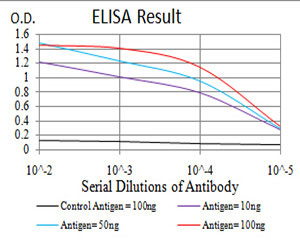SK2 Antibody
Purified Mouse Monoclonal Antibody
- SPECIFICATION
- CITATIONS
- PROTOCOLS
- BACKGROUND

Application
| IHC, FC, ICC, E |
|---|---|
| Primary Accession | Q9NRA0 |
| Reactivity | Human |
| Host | Mouse |
| Clonality | Monoclonal |
| Clone Names | 3C8D3 |
| Isotype | IgG1 |
| Calculated MW | 69.2kDa |
| Description | This gene encodes one of two sphingosine kinase isozymes that catalyze the phosphorylation of sphingosine into sphingosine 1-phosphate. Sphingosine 1-phosphate mediates many cellular processes including migration, proliferation and apoptosis, and also plays a role in several types of cancer by promoting angiogenesis and tumorigenesis. The encoded protein may play a role in breast cancer proliferation and chemoresistance. Alternatively spliced transcript variants encoding multiple isoforms have been observed for this gene. |
| Immunogen | Synthesized peptide of human SK2 (AA: 36-52). |
| Formulation | Purified antibody in PBS with 0.05% sodium azide |
| Gene ID | 56848 |
|---|---|
| Other Names | Sphingosine kinase 2, SK 2, SPK 2, 2.7.1.91, SPHK2 |
| Dilution | E~~1/10000 IF~~1/200 - 1/1000 FC~~1/200 - 1/400 IHC~~1/200 - 1/1000 |
| Storage | Maintain refrigerated at 2-8°C for up to 6 months. For long term storage store at -20°C in small aliquots to prevent freeze-thaw cycles. |
| Precautions | SK2 Antibody is for research use only and not for use in diagnostic or therapeutic procedures. |
| Name | SPHK2 (HGNC:18859) |
|---|---|
| Synonyms | SK2 |
| Function | Catalyzes the phosphorylation of sphingosine to form sphingosine-1-phosphate (SPP), a lipid mediator with both intra- and extracellular functions. Also acts on D-erythro-dihydrosphingosine, D- erythro-sphingosine and L-threo-dihydrosphingosine. Binds phosphoinositides (PubMed:12954646, PubMed:19168031). In contrast to prosurvival SPHK1, has a positive effect on intracellular ceramide levels, inhibits cells growth and enhances apoptosis (PubMed:16118219). In mitochondria, is important for cytochrome-c oxidase assembly and mitochondrial respiration. The SPP produced in mitochondria binds PHB2 and modulates the regulation via PHB2 of complex IV assembly and respiration (PubMed:20959514). In nucleus, plays a role in epigenetic regulation of gene expression. Interacts with HDAC1 and HDAC2 and, through SPP production, inhibits their enzymatic activity, preventing the removal of acetyl groups from lysine residues with histones. Up- regulates acetylation of histone H3-K9, histone H4-K5 and histone H2B- K12 (PubMed:19729656). In nucleus, may have an inhibitory effect on DNA synthesis and cell cycle (PubMed:12954646, PubMed:16103110). In mast cells, is the main regulator of SPP production which mediates calcium influx, NF-kappa-B activation, cytokine production, such as TNF and IL6, and degranulation of mast cells (By similarity). In dopaminergic neurons, is involved in promoting mitochondrial functions regulating ATP and ROS levels (By similarity). Also involved in the regulation of glucose and lipid metabolism (By similarity). |
| Cellular Location | Cytoplasm. Nucleus. Endoplasmic reticulum {ECO:0000250|UniProtKB:Q9JIA7}. Mitochondrion inner membrane {ECO:0000250|UniProtKB:Q9JIA7}. Note=In nucleus, located in nucleosomes where it associates with core histone proteins such as histone 3 (PubMed:19729656). In brains of patients with Alzheimer's disease, may be preferentially localized in the nucleus. Cytosolic expression decrease correlates with the density of amyloid deposits (PubMed:29615132). In apoptotic cells, colocalizes with CASP1 in cell membrane where is cleaved and released from cells in an active form (PubMed:20197547). |
| Tissue Location | Mainly expressed in adult kidney, liver, and brain (PubMed:10751414). Expressed in cerebral cortex and hippocampus (at protein level) (PubMed:29615132). Isoform 1 is the predominant form expressed in most tissues (PubMed:16103110) |

Thousands of laboratories across the world have published research that depended on the performance of antibodies from Abcepta to advance their research. Check out links to articles that cite our products in major peer-reviewed journals, organized by research category.
info@abcepta.com, and receive a free "I Love Antibodies" mug.
Provided below are standard protocols that you may find useful for product applications.
References
1.Tumour Biol. 2014 Jan;35(1):363-8.2.Electrophoresis. 2011 Jun;32(13):1742-9.
If you have used an Abcepta product and would like to share how it has performed, please click on the "Submit Review" button and provide the requested information. Our staff will examine and post your review and contact you if needed.
If you have any additional inquiries please email technical services at tech@abcepta.com.













 Foundational characteristics of cancer include proliferation, angiogenesis, migration, evasion of apoptosis, and cellular immortality. Find key markers for these cellular processes and antibodies to detect them.
Foundational characteristics of cancer include proliferation, angiogenesis, migration, evasion of apoptosis, and cellular immortality. Find key markers for these cellular processes and antibodies to detect them. The SUMOplot™ Analysis Program predicts and scores sumoylation sites in your protein. SUMOylation is a post-translational modification involved in various cellular processes, such as nuclear-cytosolic transport, transcriptional regulation, apoptosis, protein stability, response to stress, and progression through the cell cycle.
The SUMOplot™ Analysis Program predicts and scores sumoylation sites in your protein. SUMOylation is a post-translational modification involved in various cellular processes, such as nuclear-cytosolic transport, transcriptional regulation, apoptosis, protein stability, response to stress, and progression through the cell cycle. The Autophagy Receptor Motif Plotter predicts and scores autophagy receptor binding sites in your protein. Identifying proteins connected to this pathway is critical to understanding the role of autophagy in physiological as well as pathological processes such as development, differentiation, neurodegenerative diseases, stress, infection, and cancer.
The Autophagy Receptor Motif Plotter predicts and scores autophagy receptor binding sites in your protein. Identifying proteins connected to this pathway is critical to understanding the role of autophagy in physiological as well as pathological processes such as development, differentiation, neurodegenerative diseases, stress, infection, and cancer.






